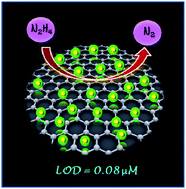Au@Pd core–shell nanoparticles-decorated reduced graphene oxide: a highly sensitive and selective platform for electrochemical detection of hydrazine†
Abstract
The tailored fabrication of noble metal-based bimetallic nanoparticles-decorated reduced graphene oxide (rGO) is highly demanding for its use as a clean and recyclable substrate for electrochemical performances. Herein, we have successfully prepared Aucore@Pdshell with an average size of ∼11.5 nm on an rGO support (denoted as GAP) through a surfactant-free one-step synthetic protocol. The use of 2-propanol as a solvent as well as a reducing agent for the precursors demonstrates that the designed process is economically preferable for the scalable synthesis of the desired GAP material. Comparative electrocatalytic efficiency in terms of hydrazine (N2H4) oxidation reveals the optimized noble-metal loading on rGO nanosheets and also the composition to capitalize maximum advantage from the as-synthesized GAP material. The most effective electrocatalyst, GAP3 with optimized constituents, was then applied as a substrate to electrochemically determine N2H4 down to a trace concentration level with high selectivity and sensitivity. The limit of detection (LOD) from GAP3 is calculated to be 0.08 μM with a linear range of 2–40 μM from the chronoamperometric (CA) result at −0.15 V vs. SCE. The novelty of N2H4 detection by the designed substrate becomes evident while all of the related reports are reviewed. This electrochemical sensor was successfully applied further to detect trace-level N2H4 in various real water samples, indicating its promising practical application.


 Please wait while we load your content...
Please wait while we load your content...